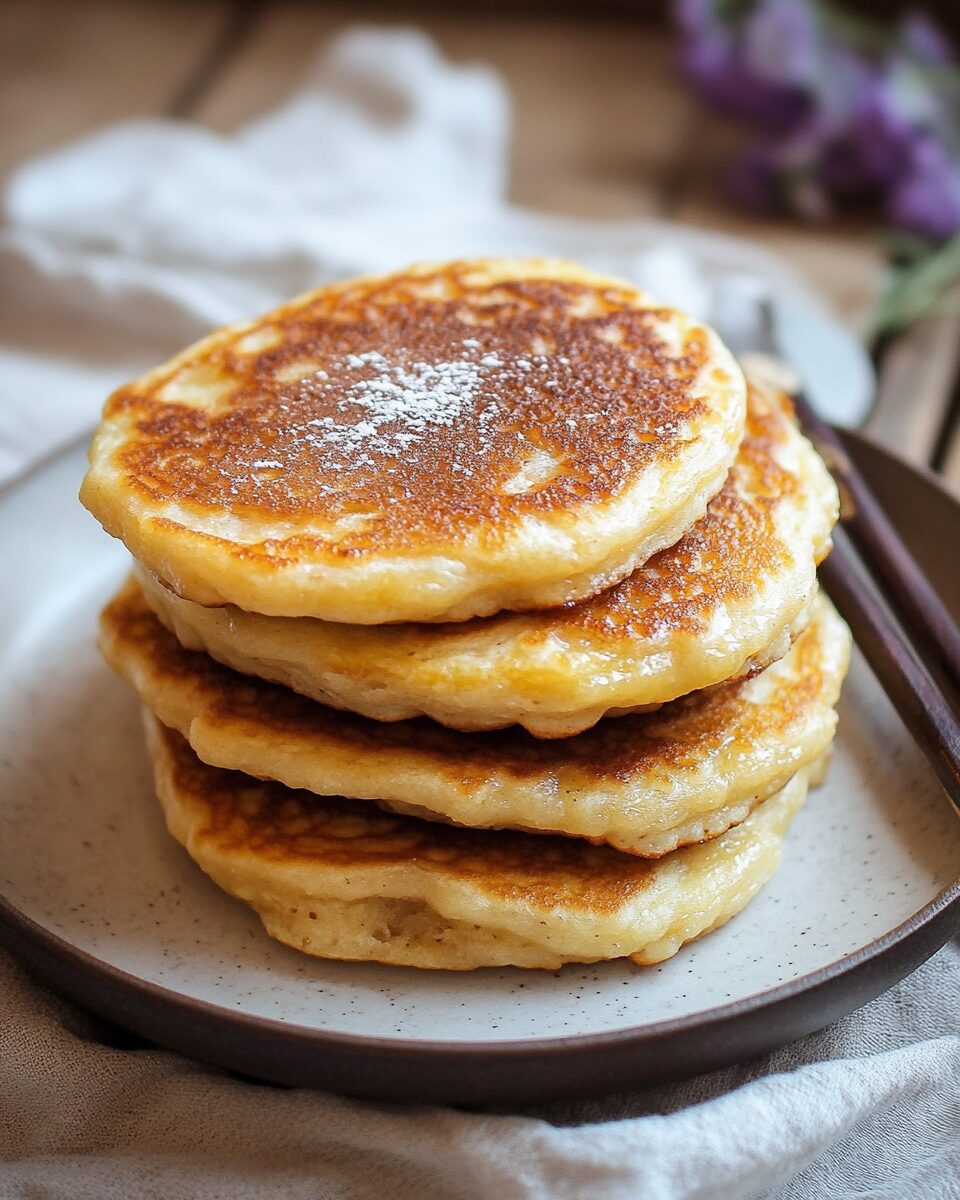Hotteok are Korean sweet pancakes made with a yeasted dough and sweet nut filling. They’re a classic street food, especially in winter, and make a delicious anytime treat.
FULL RECIPE:
Ingredients:
For the dough:
- 1¼ cups (157g) all-purpose flour
- ½ teaspoon fine sea salt
- 1 teaspoon white sugar
- 1 teaspoon instant dry yeast
- ½ cup (125ml) lukewarm milk
- Cooking oil, for frying
For the filling:
- ¼ cup dark brown sugar
- ¼ teaspoon cinnamon powder
- 2 tablespoons crushed nuts (e.g., walnuts, peanuts, or pine nuts)
Directions:
- Prepare the dough: In a large bowl, combine the flour, salt, and sugar. Dissolve the yeast in the lukewarm milk and let it sit for a few minutes until frothy. Pour the yeast mixture into the dry ingredients and mix until a dough forms. Cover the bowl with a clean cloth and let it rise in a warm place for about 1 hour, or until doubled in size.
- Prepare the filling: In a separate bowl, mix together the brown sugar, cinnamon, and crushed nuts.
- Shape the pancakes: Once the dough has risen, punch it down and divide it into 6 equal portions. Lightly oil your hands to prevent sticking. Flatten each portion into a disc, place about a tablespoon of the filling in the center, and pinch the edges together to seal, forming a ball.
- Cook the pancakes: Heat a thin layer of oil in a non-stick skillet over medium heat. Place the filled dough balls seam-side down in the skillet. Cook for about 30 seconds, then press each ball flat with a spatula. Cook for 1-2 minutes on each side, or until golden brown and crispy.
- Serve: Remove the pancakes from the skillet and drain on paper towels. Serve warm.
Nutrition Facts
- Calories: Approximately 190 kcal
- Total Fat: 6g
- Saturated Fat: 1g
- Cholesterol: 2mg
- Sodium: 120mg
- Total Carbohydrates: 33g
- Dietary Fiber: 2g
- Sugars: 11g
- Protein: 4g
The Origin of Hotteok
Hotteok has an interesting history that dates back to the late 19th and early 20th centuries when Chinese merchants introduced filled pancakes to Korea. Over time, Koreans adapted the dish, using wheat flour-based dough and incorporating sweet fillings instead of the more savory Chinese versions. Traditionally, hotteok vendors would cook the pancakes on large griddles in open markets, pressing them down with a special tool to flatten them while cooking. Today, they remain one of the most iconic street foods in Korea, often associated with wintertime comfort and nostalgia.
What Makes Hotteok Special?
One of the most appealing aspects of hotteok is its contrast in textures and flavors. The outer layer is crisp and golden brown, while the inside remains soft, chewy, and warm with a molten, sweet filling. The standard filling includes brown sugar, cinnamon, and crushed nuts, creating a delightful caramel-like center when cooked. Some modern variations incorporate honey, red bean paste, or even cheese for a unique twist. The balance between the crispy exterior and gooey center is what makes hotteok an unforgettable treat.
Variations of Hotteok
While the classic hotteok recipe remains popular, many variations have emerged to suit different preferences. Some regions in Korea have their own unique takes on this dish. For instance, some versions include seeds such as sunflower or pumpkin seeds mixed into the filling, adding an extra crunch. Others replace the traditional sweet filling with a savory mixture of vegetables, cheese, or meat, making them a satisfying meal rather than just a dessert. There are also fusion versions where ingredients like Nutella, matcha, or fruit jams are used, catering to global tastes. In modern cafes, hotteok is sometimes served with ice cream or drizzled with syrup, elevating it into a gourmet dessert.
The Popularity of Hotteok Around the World
Though deeply rooted in Korean street food culture, hotteok has gained international recognition. Thanks to the growing popularity of Korean cuisine, more people around the world are now making hotteok at home or finding it in specialty Korean bakeries and restaurants. Korean supermarkets often sell frozen or pre-made hotteok dough for easy preparation, allowing even those unfamiliar with the traditional method to enjoy them. Food bloggers and influencers have also contributed to hotteok’s rise in popularity, sharing recipes and creative ways to enjoy this treat.
The Role of Hotteok in Korean Culture
In Korea, food is often tied to memories and traditions, and hotteok is no exception. It is commonly associated with winter festivals and bustling street markets, where vendors serve freshly made pancakes to customers seeking warmth and comfort. The process of making hotteok at home is also a cherished activity for families, particularly during the colder months. Parents and grandparents often teach younger generations how to prepare the dough, fill it with sweet ingredients, and cook it to perfection. This cultural significance makes hotteok more than just a snack; it is a symbol of togetherness and tradition.
How to Enjoy Hotteok
Hotteok is best enjoyed fresh off the pan when the filling is still warm and gooey. Because of its sweetness, it pairs well with a hot beverage such as tea or coffee. Some people like to add a touch of honey or maple syrup for extra sweetness, while others prefer a dusting of powdered sugar. In Korea, it’s common to eat hotteok on the go, wrapped in parchment paper to avoid getting sticky hands. At home, hotteok can be served on a plate with additional toppings like ice cream, whipped cream, or even a sprinkle of chopped nuts. Whether eaten as a snack, dessert, or even breakfast, hotteok is versatile and always satisfying.
The Health Benefits and Nutritional Aspects of Hotteok
While hotteok is an indulgent treat, it also has some nutritional benefits, especially when made with whole grain flour or healthier fillings. The nuts used in the filling provide healthy fats, fiber, and protein, while cinnamon is known for its anti-inflammatory properties. However, traditional hotteok is relatively high in sugar and carbohydrates, making it best enjoyed in moderation. Those looking for a healthier version can experiment with using alternative flours, reducing the sugar content, or baking instead of frying the pancakes.
Why You Should Try Making Hotteok at Home
Making hotteok at home allows you to customize the ingredients and adjust the sweetness according to your preference. Unlike many desserts that require complicated techniques, hotteok is relatively simple to prepare. The most important part is letting the dough rise properly to achieve the signature chewy texture. Once you master the basic recipe, you can get creative with different fillings, from chocolate and bananas to nuts and seeds. Homemade hotteok also has the advantage of being freshly made, ensuring the best flavor and texture compared to store-bought or frozen versions.
Conclusion
Hotteok is more than just a delicious pancake; it is a beloved part of Korean food culture with a rich history and widespread appeal. Whether enjoyed from a street vendor in Seoul, made at home, or found in international cafes, hotteok continues to bring joy to those who taste it. The combination of crispy, chewy dough and sweet, nutty filling makes it a satisfying treat that appeals to people of all ages. Its versatility allows for endless variations, making it easy to adapt to different tastes and dietary preferences. If you’ve never tried hotteok before, now is the perfect time to experience this comforting and flavorful Korean delight.






